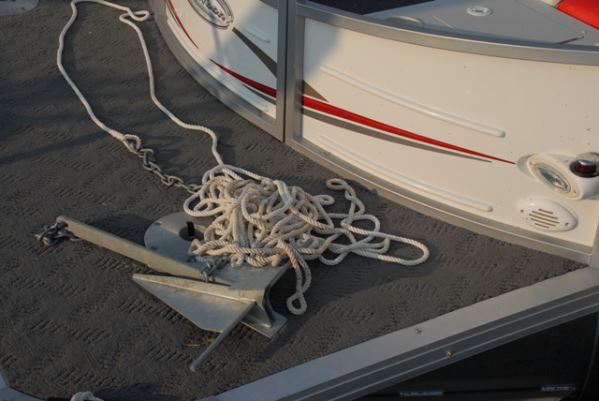 While working with anchors and thinking about the Fourth of July, the question came up about the term, “Anchors Aweigh.” What exactly does anchors aweigh really mean, and why is it “aweigh” instead of “away?” As I was thinking about this I was humming along with the “Anchors Aweigh” song in my head.
While working with anchors and thinking about the Fourth of July, the question came up about the term, “Anchors Aweigh.” What exactly does anchors aweigh really mean, and why is it “aweigh” instead of “away?” As I was thinking about this I was humming along with the “Anchors Aweigh” song in my head.
Since I wasn’t in the military, I went to the Internet to see if I could get the details. Hopefully I have got this right.
First, “Anchors Aweigh” is the fight song of the United States Naval Academy and the unofficial march song of the United States Navy. It was composed in 1906 by Charles A. Zimmermann with lyrics by Alfred Hart Miles.
Second, there’s a 1945 movie, “Anchors Aweigh” starring Frank Sinatra, Gene Kelly and Kathryn Grayson. Oh, and the cartoon characters Tom and Jerry.
But that still doesn’t help with the meaning or the spelling question. I think many of us might not have the correct understanding. How many think it means throwing the anchor overboard?
 Apparently anchors aweigh is an Old Dutch sailors' expression. To “weigh anchor” is to bring the anchor aboard a vessel. The phrase “anchors aweigh” indicates that the anchors are clear of the sea bottom and, the ship is officially “under way.” Also, you “take on the weight” of the anchor.
Apparently anchors aweigh is an Old Dutch sailors' expression. To “weigh anchor” is to bring the anchor aboard a vessel. The phrase “anchors aweigh” indicates that the anchors are clear of the sea bottom and, the ship is officially “under way.” Also, you “take on the weight” of the anchor.
On a side note, “Anchors aweigh” is often misspelled as “Anchors Away” which appears to be incorrect. Although they are sometimes used the same way.
Now all that said, anchors aweigh is about raising the anchor, but what about dropping the anchor? After searching the Internet, it became simple. All you say is, “drop anchor.” Well, duh, that was easy.
Trivia time. There’s a little used word, “a-cockbill.” That’s when you are holding the anchor ready to drop it, but haven’t released it yet. Okay, using that in a sentence the captain would say, “Hold the anchor “a-cockbill” until I tell you to drop it.”
What happens after you drop anchor? It’s `toon time! My `toon time is after the kids (or grandkids if you any) are gone, the adults hang out, enjoying food and adult beverages on the anchored pontoon.
I know, in reality, it isn’t that easy. The kids are probably diving off the `toon and swimming. The dog is running back and forth, barking at the kids. The waves are rocking the pontoon and spilling the drinks, or the pontoon is beached or in the slip. It might not really be a “drop anchor” situation, but work with me here.
.jpg_600.jpg) So here we are in the slip, on the beach, or anchored, smoking a cigar, and having a drink. Which as you can imagine, sets us on the path for a new cocktail. If you remember a while back my wife and I worked up the Pon-tini and the Tri-tini: a couple of multi-colored versions of Martinis. We are at it again, but instead of Vodka, we took a different direction for the base drink, whiskey.
So here we are in the slip, on the beach, or anchored, smoking a cigar, and having a drink. Which as you can imagine, sets us on the path for a new cocktail. If you remember a while back my wife and I worked up the Pon-tini and the Tri-tini: a couple of multi-colored versions of Martinis. We are at it again, but instead of Vodka, we took a different direction for the base drink, whiskey.
First, I need to make a few comments or disclaimers. We made the following drinks onboard our pontoon and at home, on the countertop. I also want to make it clear that we do not advocate indulging on the pontoon if you are the captain or while underway. Safe boating is always a goal for me, my crew, and passengers. On water accidents happen far too often with sober people, so why add alcohol to it? I also don’t advocate any underage drinking taking place. Again, always boat sober.
Second, glassware on a pontoon is bad. Glass breaks. Rough water and bare feet on a pontoon are too much of a risk with glass.
Back to the mixology. With my Scottish heritage (at least that’s what one of my tattoos says) we have been attending Scotch Whisky Tastings with the local Scottish Heritage group. Because of this, we are also drinking more American Whiskeys. How else do you compare a single malt Scotch Whisky if you don’t try an American made Whiskey?
.jpg_600.jpg) More trivia. Scotch basically gets its “smoky” flavor from the distilling process. Basically, the grain, which is usually barley, is malted and then heated over a “peat” fire. A whisky cannot be called Scotch unless it is entirely produced and bottled in Scotland. And note that Scotch is a Whisky (without the “e”). If you really want to experience the “peat” smoke, try an Ardbeg 10-year Scotch. It is like smelling and drinking a campfire. It could be an acquired taste.
More trivia. Scotch basically gets its “smoky” flavor from the distilling process. Basically, the grain, which is usually barley, is malted and then heated over a “peat” fire. A whisky cannot be called Scotch unless it is entirely produced and bottled in Scotland. And note that Scotch is a Whisky (without the “e”). If you really want to experience the “peat” smoke, try an Ardbeg 10-year Scotch. It is like smelling and drinking a campfire. It could be an acquired taste.
So, how’s this compared to an American Whiskey (note the “e”)? American Whiskey is made by fermenting the grain mash. Malts of various types of grains, like corn, wheat, barley and rye are used and aged in charred white oak casks.
Here’s a twist, not all Whiskeys are Bourbons. Bourbon is an American Whiskey made of at least 51 percent corn mash. If it’s not 51 percent corn mash, it’s not Bourbon. I know, way too many details for a pontoon magazine, but I thought you might be interested.
For this year’s concoction, we started with an American Whiskey and a local one to boot. Being a small business owner, we like to support other local businesses, and since a friend of ours is a sales rep for an Iowa distiller called Revelton Distilling Co. (owned by a Rob and Christi Taylor) we wanted to use their Whiskey. (www.reveltondistillery.com)
At Revelton they make a great Honey Flavored Whiskey. (They also make Honey Flavored Vodka if you just can’t take whiskey!) Plus, the bottle looks cool!
We decided to mix up a few drinks using whatever would be found in most pontoon coolers. It seems most coolers have water, pop (or is that soda?), carbonated water, beer, juice boxes, orange juice or lemonade. In our cooler we always have unsweetened iced tea.
Another goal was to reduce the need for drink “extras.” No need to have simple syrup or weird liqueurs. You can make pontoon sophisticated cocktails using the sweetness of the honey flavored Whiskey and whatever is in the cooler. Garnishes are not required, but do add to the presentation and flavor of the beverage!
Personally, I am not a sweet drink person. I don’t drink pop very often, and I don’t like sweet tea, but I will tolerate a slightly sweet cocktail or mixed drink. With keeping the drink from being too sweet as the only limitation, we started the test runs.
We have been testing the samples for a few weeks and have what we think are a few winners. All these drinks start with two ounces of Revelton’s Honey Flavored Whiskey. We tried to keep the drinks at around six ounces total, but adding or deleting some of the mixers might suit your tastes.
.jpg_600.jpg) Here is what we liked the best.
Here is what we liked the best.
- Tooned Up Tea: Whiskey with four ounces of unsweetened iced tea and garnished with a slice of lemon. This gave me a bit of a “sweet tea” flavor, but not too much.
- Cow Toon: Whiskey and New Glarus Spotted Cow beer (Wisconsin light ale) and garnished with a slice of orange. Who knew this would work?
- Arnold Palmer ‘Toon: Whiskey with two ounces of lemonade and two ounces of unsweetened tea and garnished with a slice of lemon.
- Pontoon Mimosa: Whiskey with four ounces of orange juice and garnished with a slice of orange and a Maraschino cherry.
- Toon Fizz: Whiskey with four ounces of lemon-flavored carbonated water. Simple, bubbly and slightly sweet. Plus, low calorie!
- Old Fashioned Pontoon: Whiskey with two ounces of cherry flavored carbonated water with frozen sweet cherries to cool it down and garnished with an orange slice.
And another thing, we thought it would be great to have anchor shaped ice cubes. So we bought a mold and added red and blue food coloring. I’ll warn you right now, that’s not such a great idea. My fingers are still blue.
Oh and one more thing, since we started this research of Whiskey drinks, we learned about improving “cheap” Whiskey. On TikTok there was a video about taking low-cost, but decent, Whiskey and adding American Oak Infusion Spirals and improving the taste and smoothness. Apparently, these oak spirals are popular for beer and wine makers. They are readily available online.
So stay tuned. We have quart Mason jars filled with Evan Williams Bottled-in-Bond Whiskey and a small section of a Medium Toast wood spiral soaking in the Whiskey. Biggest issue is leaving them alone for the next six weeks while they are infusing the new oak flavor.

